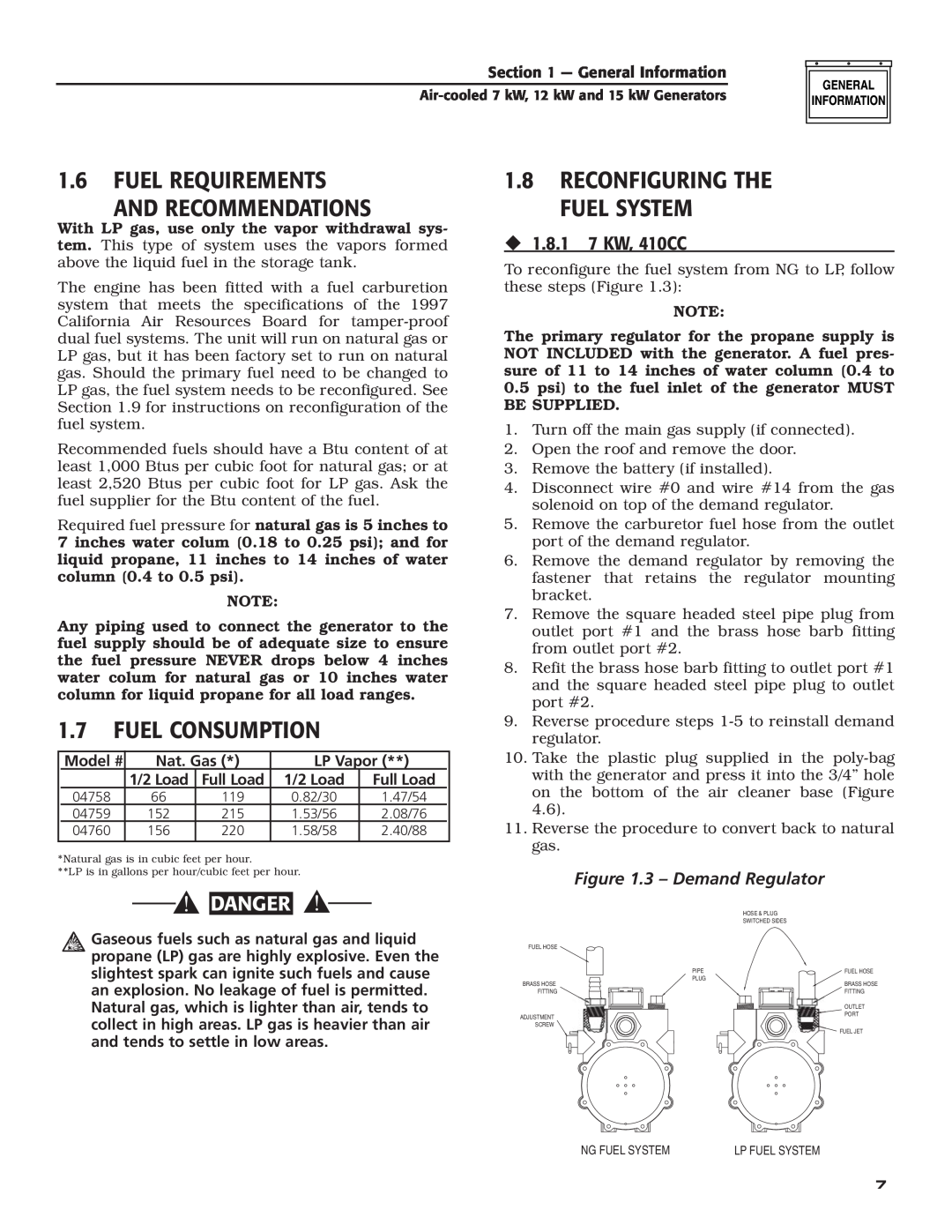04760-2 13 kW NG, 15 kW LP
Models 04758-2 6 kW NG, 7 kW LP 04759-2 12 kW NG, 12 kW LP
This manual should remain with the unit
Not intended for use as Primary Power in place of utility
‹ OPERATION AND MAINTENANCE
‹ CONTENTS
‹ HOW TO OBTAIN SERVICE
INTRODUCTION
and Adjustments
Section 2 - Post Installation Start-up
Section 4 - Maintenance
Section 5 - Troubleshooting
IMPORTANT SAFETY INSTRUCTIONS
GENERAL HAZARDS
WARNING
This product contains or emits chemicals
FIRE HAZARDS
ELECTRICAL HAZARDS
EXPLOSION HAZARDS
‹ STANDARDS INDEX
1.2 PROTECTION SYSTEMS
1.1 UNPACKING/INSPECTION
1.3 SYSTEM SET LED
DANGER
1.4 THE GENERATOR
Figure 1.1 - 7 kW, Single Cylinder GH-410 Engine
Figure 1.2 - 12 kW/15 kW, V-twin GT-990/760 Engine
1.5 SPECIFICATIONS
‹ 1.5.1 GENERATOR
‹ 1.5.2 ENGINE
1.6 FUEL REQUIREMENTS AND RECOMMENDATIONS
1.8 RECONFIGURING THE FUEL SYSTEM
1.7 FUEL CONSUMPTION
DANGER
‹ 1.8.2 12KW AND 15KW, 990CC ENGINES
1.9 LOCATION
‹ 1.9.1 GENERATOR
Figure 1.4 - Demand Regulator
1.11 THE BATTERY
1.10 BATTERY INSTALLATION
‹ 1.9.2 TRANSFER SWITCH 1.9.2.1 7 kW, 12 kW and 15 kW Units
Figure 1.5 - Battery Cable Connections
2.1 BEFORE INITIAL START-UP
2.2 CHECK TRANSFER SWITCH OPERATION
2.3 ELECTRICAL CHECKS
Section 2 - Post Installation Start-up and Adjustments
2.5 CHECKING AUTOMATIC OPERATION
2.4 GENERATOR TESTS UNDER LOAD
2.6 ADJUSTING THE REGULATOR NATURAL GAS ONLY
Figure 2.2 - Placement of Regulator
Figure 2.1 - Dual Fuel Regulators
Figure 2.3 - Single Cylinder Engine Governor Adjustment
2.7 ENGINE GOVERNOR ADJUSTMENT
Figure 2.4 - V-twin Engine Governor Adjustment
Figure 2.5 - V-twin Full Load Speed Adjust Screw
3.1 BREAK-IN PROCEDURE
2.8 VOLTAGE REGULATOR ADJUSTMENT
Figure 2.6 - Voltage Adjustment Potentiometer
‹ 3.2.1 “AUTO” POSITION
3.4 SEQUENCE OF AUTOMATIC OPERATION
3.3 AUTOMATIC TRANSFER OPERATION
3.5 MANUAL TRANSFER OPERATION
‹ 3.5.1 TRANSFER TO GENERATOR POWER SOURCE
‹ 3.5.2 TRANSFER BACK TO UTILITY POWER SOURCE
3.6 SETTING THE EXERCISE TIMER
‹ 3.7.1 LOW OIL PRESSURE SWITCH
Figure 3.2 - Manual Transfer Switch Operation
Figure 3.3 - Low Oil Pressure and High Temperature Switches
‹ 3.7.2 HIGH TEMPERATURE SWITCH
4.1 FUSE
4.2 CHECKING THE ENGINE OIL LEVEL
‹ 4.3.2 OIL CHANGE PROCEDURE
4.5 CHANGING THE ENGINE AIR CLEANER
4.3 CHANGING THE ENGINE OIL
4.4 CHANGING THE OIL FILTER
Figure 4.6 - 7 kW, Engine Air Cleaner Location
4.7 BATTERY MAINTENANCE
Figure 4.7 - 12 kW and 15 kW Engine Air Cleaner
Figure 4.8 - Setting the Spark Plug Gap
4.8 ADJUSTING VALVE CLEARANCE
Figure 4.10 - Valve Clearance Adjustment
4.9 COOLING SYSTEM
‹ 4.12.1 REMOVAL FROM SERVICE
4.12 OUT OF SERVICE PROCEDURE
‹ 4.12.2 RETURN TO SERVICE
4.10 ATTENTION AFTER SUBMERSION
4.13 SERVICE SCHEDULE
ATTENTION It is recommended that all service work
be performed by the nearest Authorized Dealer
Problem
5.1 TROUBLESHOOTING GUIDE
Cause
Correction
Section 6 - Electrical Data
ENGINE WIRING
CONTROL PANEL BOX
CUSTOMER
CONNECTION
Electrical Schematic - 12 & 15 kW - Drawing No. 0D8501-B
Section 6 - Electrical Data
Section 6 - Electrical Data
ENGINE WIRING
Section 6 - Electrical Data
224A
225A
Electrical Schematic - 7 kW - Drawing No. 0D9014-C
PRE PACKAGED UNITS ONLY
Section 7 - Exploded Views and Parts Lists
CLOTH, HARDWARE 266.7mm x 146mm 7KW
PART NO. QTY. DESCRIPTION
FOAM, EXHAUST SIDE ENCLOSURE FRONT
FOAM, BACK EXHAUST ENCLOSURE COVER
Section 7 - Exploded Views and Parts Lists
DESCRIPTION
PART NO. QTY
66 2, 5, 19, 20, 39, 40, 47, 64, 93 67 8, 11, 12 68 4, 5
Views and Parts Lists
69 16A, 16B, 17
72 27, 28 73 3, 32, 33, 34, 35, 36, 40
ASSEMBLY, CRANKSHAFT HORIZONTAL
ASSEMBLY, CRANKCASE HOUSING WITH
ITEM PART NO. QTY. DESCRIPTION
ROLLER BEARING, GOVERNOR PLATE
Section 7 - Exploded Views and Parts Lists
ASSY, IGNITION COIL GV-990 CYLINDER
7 kW Generator - Drawing No. 0D3504-E
1.25 FT
1.8 FT
32 31
12 kW and 15 kW Generator - Drawing No. 0D3417-L
2.6 FT
3 FT
1.44 FT
Section 7 - Exploded Views and Parts Lists
DESCRIPTION
Section 7 - Exploded Views and Parts Lists
Section 7 - Exploded Views and Parts Lists
DESCRIPTION
Section 7 - Exploded Views and Parts Lists
Section 7 - Exploded Views and Parts Lists
DESCRIPTION
Section 8 - Mounting
ALL DIMENSIONS IN MILLIMETERS INCHES
Drawing No
Air-cooled
Section 9 - Notes
MANUFACTURER’S EMISSION CONTROL SYSTEM WARRANTY COVERAGE
YOUR WARRANTY RIGHTS AND OBLIGATIONS
PURCHASER’S/OWNER’S WARRANTY RESPONSIBILITIES
CALIFORNIA AND FEDERAL EMISSION CONTROL WARRANTY STATEMENT
EMISSION RELATED PARTS INCLUDE THE FOLLOWING
EMISSION CONTROL SYSTEM WARRANTY
WARRANTY SCHEDULE
GENERAC POWER SYSTEMS TWO YEAR LIMITED WARRANTY FOR GUARDIAN
THIS WARRANTY SHALL NOT APPLY TO THE FOLLOWING
PREPACKAGED EMERGENCY AUTOMATIC STANDBY GENERATORS
